Unit 2 Morals and Virtues Reading for Writing 课件(共25张)2024-2025学年高一英语人教版(2019)必修3
文档属性
| 名称 | Unit 2 Morals and Virtues Reading for Writing 课件(共25张)2024-2025学年高一英语人教版(2019)必修3 | 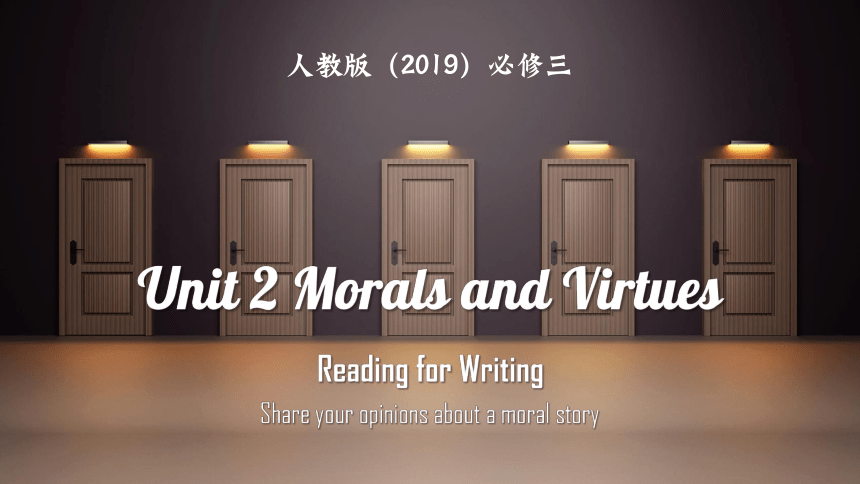 | |
| 格式 | pptx | ||
| 文件大小 | 43.7MB | ||
| 资源类型 | 教案 | ||
| 版本资源 | 人教版(2019) | ||
| 科目 | 英语 | ||
| 更新时间 | 2025-04-16 13:32:40 | ||
图片预览

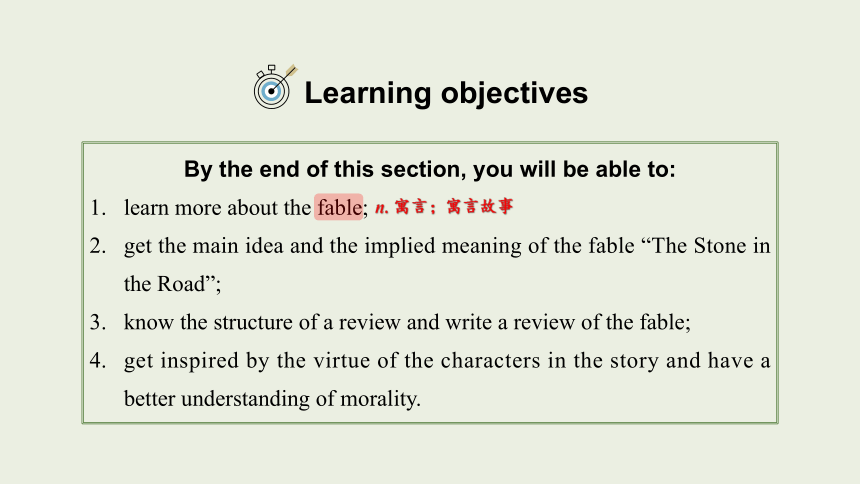
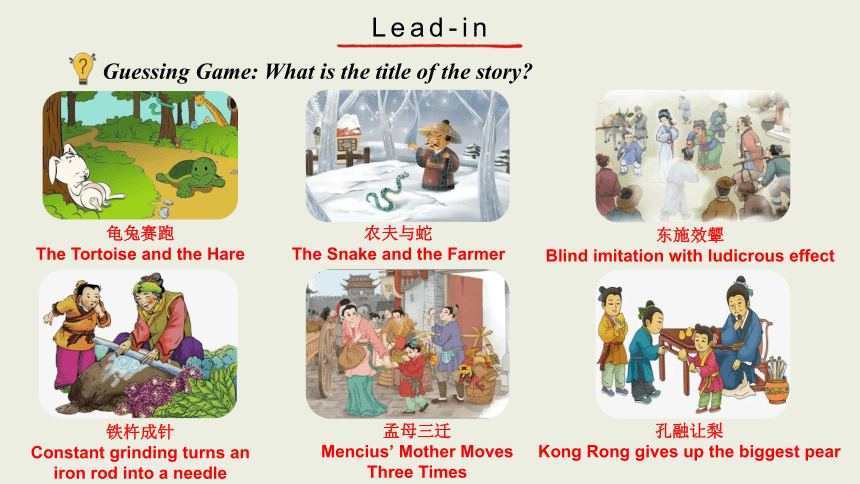
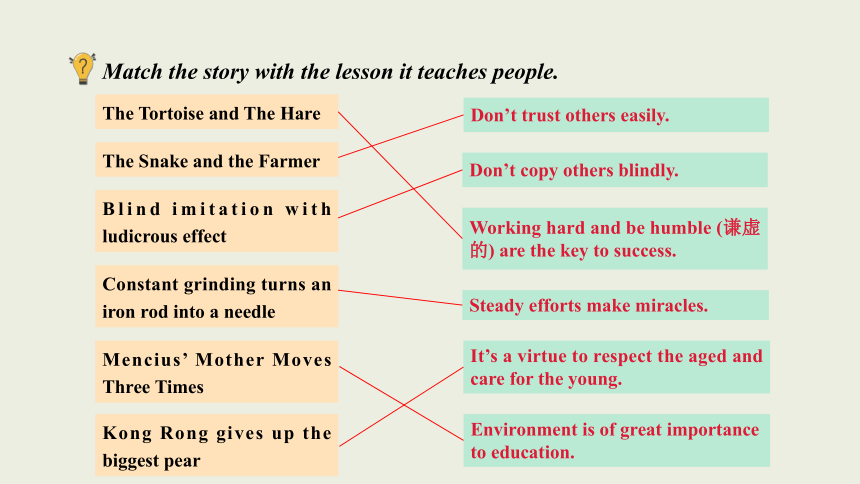

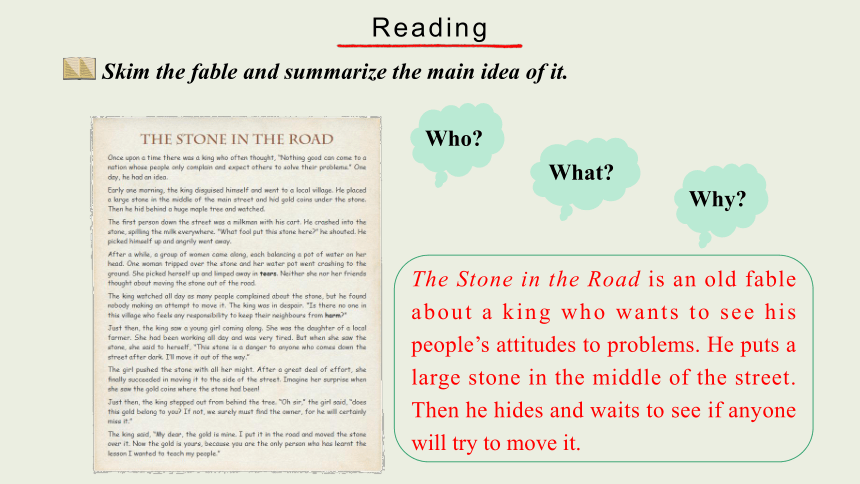


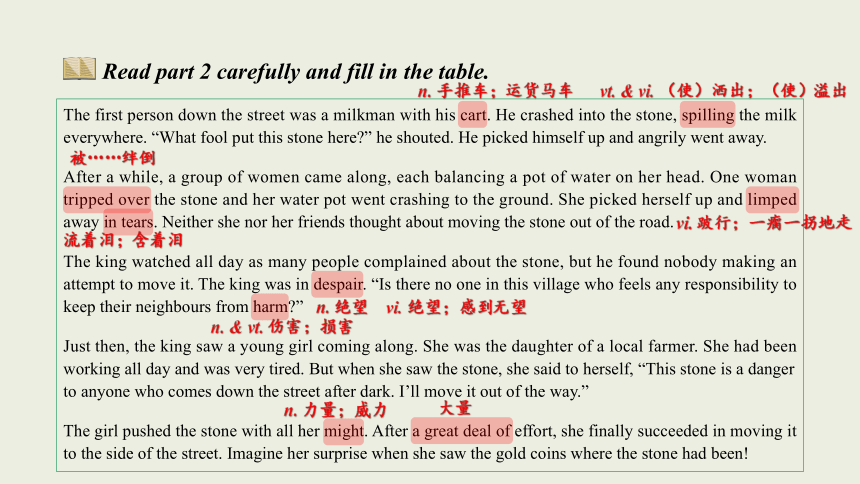
文档简介
(共25张PPT)
人教版(2019)必修三
Unit 2 Morals and Virtues
Reading for Writing
Share your opinions about a moral story
Learning objectives
By the end of this section, you will be able to:
learn more about the fable;
get the main idea and the implied meaning of the fable “The Stone in the Road”;
know the structure of a review and write a review of the fable;
get inspired by the virtue of the characters in the story and have a better understanding of morality.
n. 寓言;寓言故事
Lead-in
Guessing Game: What is the title of the story
龟兔赛跑
The Tortoise and the Hare
农夫与蛇
The Snake and the Farmer
东施效颦
Blind imitation with ludicrous effect
铁杵成针
Constant grinding turns an iron rod into a needle
孟母三迁
Mencius’ Mother Moves Three Times
孔融让梨
Kong Rong gives up the biggest pear
Match the story with the lesson it teaches people.
Kong Rong gives up the biggest pear
Mencius’ Mother Moves Three Times
The Tortoise and The Hare
The Snake and the Farmer
Blind imitation with ludicrous effect
Constant grinding turns an iron rod into a needle
Working hard and be humble (谦虚的) are the key to success.
Don’t trust others easily.
Don’t copy others blindly.
Steady efforts make miracles.
It’s a virtue to respect the aged and care for the young.
Environment is of great importance to education.
What is the type of the above stories
For example, The Race Between the Tortoise and the Hare.
fable
寓言
It’s a kind of traditional short story.
It teaches a moral lesson.
It’s usually a story with animals as characters.
These stories are always considered as a group.
Reading
Skim the fable and summarize the main idea of it.
Who
What
Why
The Stone in the Road is an old fable about a king who wants to see his people’s attitudes to problems. He puts a large stone in the middle of the street. Then he hides and waits to see if anyone will try to move it.
Analyse the structure of the text.
Part 2
paras. ____
Different people’s _________ and _________ when they came across the same problem.
What _______ the king taught his people.
Part 1
paras. ____
Part 3
paras. ____
Why the king wanted to __________________ and what _______ was.
THE STONE IN THE ROAD
teach his people a lesson
his idea
emotions
responses
lesson
1-2
3-7
8-9
Read part 1 carefully and fill in the table.
Once upon a time there was a king who often thought, “Nothing good can come to a nation whose people only complain and expect others to solve their problems.” One day, he had an idea.
Early one morning, the king disguised himself and went to a local village. He placed a large stone in the middle of the main street and hid gold coins under the stone. Then he hid behind a huge maple tree and watched.
Part 1: Cause When Early one morning
Where
Who The king
What Placed a large _____ in the middle of the main street and hid ___________ under the stone.
Why To _____ whether people would _____ it.
stone
gold coins
A local village
test
move
vt. 装扮;假扮;掩盖 n. 伪装;化装用具
n. 枫树;槭树
Read part 2 carefully and fill in the table.
The first person down the street was a milkman with his cart. He crashed into the stone, spilling the milk everywhere. “What fool put this stone here ” he shouted. He picked himself up and angrily went away.
After a while, a group of women came along, each balancing a pot of water on her head. One woman tripped over the stone and her water pot went crashing to the ground. She picked herself up and limped away in tears. Neither she nor her friends thought about moving the stone out of the road.
The king watched all day as many people complained about the stone, but he found nobody making an attempt to move it. The king was in despair. “Is there no one in this village who feels any responsibility to keep their neighbours from harm ”
Just then, the king saw a young girl coming along. She was the daughter of a local farmer. She had been working all day and was very tired. But when she saw the stone, she said to herself, “This stone is a danger to anyone who comes down the street after dark. I’ll move it out of the way.”
The girl pushed the stone with all her might. After a great deal of effort, she finally succeeded in moving it to the side of the street. Imagine her surprise when she saw the gold coins where the stone had been!
n. 手推车;运货马车
vt. & vi. (使)洒出;(使)溢出
被……绊倒
vi. 跛行;一瘸一拐地走
流着泪;含着泪
n. 绝望 vi. 绝望;感到无望
n. & vt. 伤害;损害
n. 力量;威力
大量
Person Experience Emotion Response
milkman crashed into the stone angry went away
woman with water
other villagers
young girl
tripped over the stone
sad
limped away in tears
complained about the stone
upset
nobody made an attempt to move the stone
succeeded in moving the stone to the side of the street
tired,
surprised
wanted to find the owner of the gold
___________ about the stone
thought for ___________
complained
themselves
Indifferent
漠不关心的
________ the stone
thought for ________
moved
others
Responsible
有责任感的
Read part 3 carefully and decide whether the statements are True or False.
Just then, the king stepped out from behind the tree. “Oh sir,” the girl said, “does this gold belong to you If not, we surely must find the owner, for he will certainly miss it.”
The king said, “My dear, the gold is mine. I put it in the road and moved the stone over it. Now the gold is yours, because you are the only person who has learnt the lesson I wanted to teach my people.”
1. The girl moved the stone, but got nothing.
2. The king found the person who had learnt the lesson he wanted to teach his
people.
F
T
Read the fable again and answer the following questions.
What was the king’s idea for teaching an important lesson to his people
What was the response from most of the people
What did the young girl think and do when she saw the coins
He put a huge stone in the middle of a road, and watched to see if anyone would move it.
Most of the people just got upset that the stone was in their way.
She thought that the money belonged to someone else and that it should be returned.
What do you think this fable is trying to tell us Do you think the king was wise Why or why not
The moral of the story is that we should all take responsibility for our community.
I don’t think that the king was very wise, however, because no one learnt anything from his experiment. The milkman, the woman with her water pot, and the other villagers continued on their travels without having changed their attitudes at all. The king did find one responsible young girl, but she was already a responsible person before she encountered the stone in the road.
Suggested Answer
Work in pairs. Discuss the questions.
Can you think of times in your own life when you felt and acted like the girl or like the other people in the story Give examples.
There have been times when I have acted responsibly like the girl in the story. For example, I recently saw some children playing on a dangerous balcony, and so I warned them it was dangerous and had them go somewhere else to play. However, often I’m more like the milkman in the story because I’m very busy with my own work and worries.
Suggested Answer
Writing
Learn how to write a review of the fable.
What is a review
main purpose: to give your opinion about a piece of writing
give a short description of the writing
give your analysis of the writing
state your opinion and your reasons
How to write a review of a fable
Basic information about the story
Your analysis of the story
Your opinion about the story
Paragraph 1:
Basic information
What is the title of the story
What kind of story is it
What is the main idea of the story
Paragraph 2:
Your analysis of
the story
Paragraph 3:
Your opinion about
the story
What is the author’s purpose
Were the details of the story clear
Do you think the story achieved its purpose
What did you like about the story
What did you not like about the story
Would you recommend this story to others
Write a review of the fable. Use the outline below to help you.
Sample: The Stone in the Road is an old fable about a king who wanted to teach his people a lesson by hiding gold under the stone in the street.
Sample: The author used the story to impress on readers the need to take personal responsibility for problems in the community. The story is quite successful in achieving its purpose, and I like it because it has a clear moral.
Sample: However, while the moral of the story is clear, the actions of the king seemed pointless to me, because none of the characters in the story learnt anything. For this reason, I think there are better stories that can be used to impress on people the need for personal responsibility.
“The Stone in the Road” is an old fable about a king who wants to see his people’s attitudes to problems. He puts a large stone in the middle of the road. Then he hides and waits to see if anyone will try to move it.
The author used this story to impress upon readers the need to take personal responsibility for problems in the community. The story was quite successful in achieving its purpose, and I liked it because it had a clear moral.
However, while the moral of the story is clear, the actions of the king seemed pointless to me, because none of the characters in the story learnt anything. For this reason, I think there are better stories that can be used to impress upon people the need for personal responsibility.
Sample Writing
Does the writer give a short description of the story
Does the description include the most important details of the story
Does the writer give his/her opinion about the characters or their actions
Is the review well-organised
Does the writer use the -ing form as the adverbial in the review
Are there any grammar, spelling, or punctuation errors
Exchange drafts. Use the checklist to give feedback on your partner’s draft.
Get your draft back and revise it. Then put your review up in the classroom.
She picked herself up and limped away in tears. (P20)
她从地上爬起来,噙着泪一瘸一拐地走了。
tear /t (r)/ n. 眼泪;泪水
搭配
in tears 流着泪;含着泪
be close to tears 快流泪了
burst into tears = burst out crying 突然大哭起来
例句
My sister was close to tears when we waved goodbye to her.
当我们挥手和我姐姐道别时,她差点儿哭了出来。
Between astonishment and joy, she couldn’t help bursting into tears.
她又惊又喜,忍不住哭了起来。
Language points
1
拓展
tear vt. & vi. 撕碎,扯破 vt. 撕开,扯开(裂口或洞)(tear—tore—torn)
tear up 撕碎,撕毁(合同等)
tear down 拆毁,拆除(建筑物、墙等)
例句
They tore down many old buildings in a rush in the past decades to build skyscrapers.
在过去的几十年里他们匆忙拆毁了很多建筑来建造摩天大楼。
He was so angry as to tear up the letter and throw it into the wastebasket.
他太生气了,于是把信撕了并扔进了废纸篓。
The king was in despair. (P20)
国王陷入了绝望。
despair /d spe (r)/ n. 绝望 vi. 绝望;感到无望
搭配
in despair 处于绝望中
例句
Despair choked her words.
她绝望得说不出话来。
I looked at my wife in despair.
我绝望地看着妻子。
拓展
desperation n. 绝望,拼命;急需,渴求
2
Is there no one in this village who feels any responsibility to keep their neighbours from harm (P20)
难道整个村子都没有一个人觉得有责任让邻居免遭不测吗?
harm /hɑ m/ n. & vt. 伤害;损害
搭配
do harm to sb/sth = do sb/sth harm 对某人/某物有害
例句
I’m afraid that the heavy rain will do great harm to the crops.
我担心这场大雨会给庄稼带来很大的危害。
拓展
harmful adj. 有害的 be harmful to ... 对……有害
harmless adj. 无害的
3
After a great deal of effort, she finally succeeded in moving it to the side of the street. (P20)
费了好大一番工夫,她终于成功地把石头推到了路边。
a great deal of 大量(+不可数名词)
例句
She spent a great deal of time visiting the poor.
她花了很多时间看望穷人。
拓展
a great deal单独使用时,相当于副词。
Your contribution means a great deal not only to this organization, but also to the whole world.
你们的贡献意义重大,不仅是对于这个组织,而且是对于整个世界。
4
Homework
Polish your reviews based on the teacher’s and classmates’ suggestions.
人教版(2019)必修三
Unit 2 Morals and Virtues
Reading for Writing
Share your opinions about a moral story
Learning objectives
By the end of this section, you will be able to:
learn more about the fable;
get the main idea and the implied meaning of the fable “The Stone in the Road”;
know the structure of a review and write a review of the fable;
get inspired by the virtue of the characters in the story and have a better understanding of morality.
n. 寓言;寓言故事
Lead-in
Guessing Game: What is the title of the story
龟兔赛跑
The Tortoise and the Hare
农夫与蛇
The Snake and the Farmer
东施效颦
Blind imitation with ludicrous effect
铁杵成针
Constant grinding turns an iron rod into a needle
孟母三迁
Mencius’ Mother Moves Three Times
孔融让梨
Kong Rong gives up the biggest pear
Match the story with the lesson it teaches people.
Kong Rong gives up the biggest pear
Mencius’ Mother Moves Three Times
The Tortoise and The Hare
The Snake and the Farmer
Blind imitation with ludicrous effect
Constant grinding turns an iron rod into a needle
Working hard and be humble (谦虚的) are the key to success.
Don’t trust others easily.
Don’t copy others blindly.
Steady efforts make miracles.
It’s a virtue to respect the aged and care for the young.
Environment is of great importance to education.
What is the type of the above stories
For example, The Race Between the Tortoise and the Hare.
fable
寓言
It’s a kind of traditional short story.
It teaches a moral lesson.
It’s usually a story with animals as characters.
These stories are always considered as a group.
Reading
Skim the fable and summarize the main idea of it.
Who
What
Why
The Stone in the Road is an old fable about a king who wants to see his people’s attitudes to problems. He puts a large stone in the middle of the street. Then he hides and waits to see if anyone will try to move it.
Analyse the structure of the text.
Part 2
paras. ____
Different people’s _________ and _________ when they came across the same problem.
What _______ the king taught his people.
Part 1
paras. ____
Part 3
paras. ____
Why the king wanted to __________________ and what _______ was.
THE STONE IN THE ROAD
teach his people a lesson
his idea
emotions
responses
lesson
1-2
3-7
8-9
Read part 1 carefully and fill in the table.
Once upon a time there was a king who often thought, “Nothing good can come to a nation whose people only complain and expect others to solve their problems.” One day, he had an idea.
Early one morning, the king disguised himself and went to a local village. He placed a large stone in the middle of the main street and hid gold coins under the stone. Then he hid behind a huge maple tree and watched.
Part 1: Cause When Early one morning
Where
Who The king
What Placed a large _____ in the middle of the main street and hid ___________ under the stone.
Why To _____ whether people would _____ it.
stone
gold coins
A local village
test
move
vt. 装扮;假扮;掩盖 n. 伪装;化装用具
n. 枫树;槭树
Read part 2 carefully and fill in the table.
The first person down the street was a milkman with his cart. He crashed into the stone, spilling the milk everywhere. “What fool put this stone here ” he shouted. He picked himself up and angrily went away.
After a while, a group of women came along, each balancing a pot of water on her head. One woman tripped over the stone and her water pot went crashing to the ground. She picked herself up and limped away in tears. Neither she nor her friends thought about moving the stone out of the road.
The king watched all day as many people complained about the stone, but he found nobody making an attempt to move it. The king was in despair. “Is there no one in this village who feels any responsibility to keep their neighbours from harm ”
Just then, the king saw a young girl coming along. She was the daughter of a local farmer. She had been working all day and was very tired. But when she saw the stone, she said to herself, “This stone is a danger to anyone who comes down the street after dark. I’ll move it out of the way.”
The girl pushed the stone with all her might. After a great deal of effort, she finally succeeded in moving it to the side of the street. Imagine her surprise when she saw the gold coins where the stone had been!
n. 手推车;运货马车
vt. & vi. (使)洒出;(使)溢出
被……绊倒
vi. 跛行;一瘸一拐地走
流着泪;含着泪
n. 绝望 vi. 绝望;感到无望
n. & vt. 伤害;损害
n. 力量;威力
大量
Person Experience Emotion Response
milkman crashed into the stone angry went away
woman with water
other villagers
young girl
tripped over the stone
sad
limped away in tears
complained about the stone
upset
nobody made an attempt to move the stone
succeeded in moving the stone to the side of the street
tired,
surprised
wanted to find the owner of the gold
___________ about the stone
thought for ___________
complained
themselves
Indifferent
漠不关心的
________ the stone
thought for ________
moved
others
Responsible
有责任感的
Read part 3 carefully and decide whether the statements are True or False.
Just then, the king stepped out from behind the tree. “Oh sir,” the girl said, “does this gold belong to you If not, we surely must find the owner, for he will certainly miss it.”
The king said, “My dear, the gold is mine. I put it in the road and moved the stone over it. Now the gold is yours, because you are the only person who has learnt the lesson I wanted to teach my people.”
1. The girl moved the stone, but got nothing.
2. The king found the person who had learnt the lesson he wanted to teach his
people.
F
T
Read the fable again and answer the following questions.
What was the king’s idea for teaching an important lesson to his people
What was the response from most of the people
What did the young girl think and do when she saw the coins
He put a huge stone in the middle of a road, and watched to see if anyone would move it.
Most of the people just got upset that the stone was in their way.
She thought that the money belonged to someone else and that it should be returned.
What do you think this fable is trying to tell us Do you think the king was wise Why or why not
The moral of the story is that we should all take responsibility for our community.
I don’t think that the king was very wise, however, because no one learnt anything from his experiment. The milkman, the woman with her water pot, and the other villagers continued on their travels without having changed their attitudes at all. The king did find one responsible young girl, but she was already a responsible person before she encountered the stone in the road.
Suggested Answer
Work in pairs. Discuss the questions.
Can you think of times in your own life when you felt and acted like the girl or like the other people in the story Give examples.
There have been times when I have acted responsibly like the girl in the story. For example, I recently saw some children playing on a dangerous balcony, and so I warned them it was dangerous and had them go somewhere else to play. However, often I’m more like the milkman in the story because I’m very busy with my own work and worries.
Suggested Answer
Writing
Learn how to write a review of the fable.
What is a review
main purpose: to give your opinion about a piece of writing
give a short description of the writing
give your analysis of the writing
state your opinion and your reasons
How to write a review of a fable
Basic information about the story
Your analysis of the story
Your opinion about the story
Paragraph 1:
Basic information
What is the title of the story
What kind of story is it
What is the main idea of the story
Paragraph 2:
Your analysis of
the story
Paragraph 3:
Your opinion about
the story
What is the author’s purpose
Were the details of the story clear
Do you think the story achieved its purpose
What did you like about the story
What did you not like about the story
Would you recommend this story to others
Write a review of the fable. Use the outline below to help you.
Sample: The Stone in the Road is an old fable about a king who wanted to teach his people a lesson by hiding gold under the stone in the street.
Sample: The author used the story to impress on readers the need to take personal responsibility for problems in the community. The story is quite successful in achieving its purpose, and I like it because it has a clear moral.
Sample: However, while the moral of the story is clear, the actions of the king seemed pointless to me, because none of the characters in the story learnt anything. For this reason, I think there are better stories that can be used to impress on people the need for personal responsibility.
“The Stone in the Road” is an old fable about a king who wants to see his people’s attitudes to problems. He puts a large stone in the middle of the road. Then he hides and waits to see if anyone will try to move it.
The author used this story to impress upon readers the need to take personal responsibility for problems in the community. The story was quite successful in achieving its purpose, and I liked it because it had a clear moral.
However, while the moral of the story is clear, the actions of the king seemed pointless to me, because none of the characters in the story learnt anything. For this reason, I think there are better stories that can be used to impress upon people the need for personal responsibility.
Sample Writing
Does the writer give a short description of the story
Does the description include the most important details of the story
Does the writer give his/her opinion about the characters or their actions
Is the review well-organised
Does the writer use the -ing form as the adverbial in the review
Are there any grammar, spelling, or punctuation errors
Exchange drafts. Use the checklist to give feedback on your partner’s draft.
Get your draft back and revise it. Then put your review up in the classroom.
She picked herself up and limped away in tears. (P20)
她从地上爬起来,噙着泪一瘸一拐地走了。
tear /t (r)/ n. 眼泪;泪水
搭配
in tears 流着泪;含着泪
be close to tears 快流泪了
burst into tears = burst out crying 突然大哭起来
例句
My sister was close to tears when we waved goodbye to her.
当我们挥手和我姐姐道别时,她差点儿哭了出来。
Between astonishment and joy, she couldn’t help bursting into tears.
她又惊又喜,忍不住哭了起来。
Language points
1
拓展
tear vt. & vi. 撕碎,扯破 vt. 撕开,扯开(裂口或洞)(tear—tore—torn)
tear up 撕碎,撕毁(合同等)
tear down 拆毁,拆除(建筑物、墙等)
例句
They tore down many old buildings in a rush in the past decades to build skyscrapers.
在过去的几十年里他们匆忙拆毁了很多建筑来建造摩天大楼。
He was so angry as to tear up the letter and throw it into the wastebasket.
他太生气了,于是把信撕了并扔进了废纸篓。
The king was in despair. (P20)
国王陷入了绝望。
despair /d spe (r)/ n. 绝望 vi. 绝望;感到无望
搭配
in despair 处于绝望中
例句
Despair choked her words.
她绝望得说不出话来。
I looked at my wife in despair.
我绝望地看着妻子。
拓展
desperation n. 绝望,拼命;急需,渴求
2
Is there no one in this village who feels any responsibility to keep their neighbours from harm (P20)
难道整个村子都没有一个人觉得有责任让邻居免遭不测吗?
harm /hɑ m/ n. & vt. 伤害;损害
搭配
do harm to sb/sth = do sb/sth harm 对某人/某物有害
例句
I’m afraid that the heavy rain will do great harm to the crops.
我担心这场大雨会给庄稼带来很大的危害。
拓展
harmful adj. 有害的 be harmful to ... 对……有害
harmless adj. 无害的
3
After a great deal of effort, she finally succeeded in moving it to the side of the street. (P20)
费了好大一番工夫,她终于成功地把石头推到了路边。
a great deal of 大量(+不可数名词)
例句
She spent a great deal of time visiting the poor.
她花了很多时间看望穷人。
拓展
a great deal单独使用时,相当于副词。
Your contribution means a great deal not only to this organization, but also to the whole world.
你们的贡献意义重大,不仅是对于这个组织,而且是对于整个世界。
4
Homework
Polish your reviews based on the teacher’s and classmates’ suggestions.
